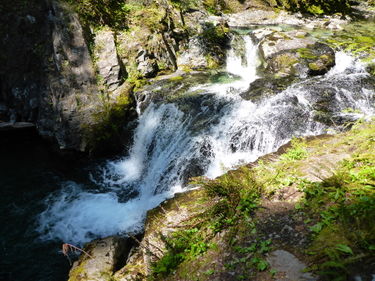Gold Creek Canyoneering Canyoning Caving
|
| Rating: |
Log in to rateLog in to rateLog in to rateLog in to rateLog in to rate 2.0 (1 rating) |
|

|
| |
Raps:1, max ↨20ft | Overall: | | ⟷2.4mi |
|---|
| ⟷0.7mi | ↓157ft |
Closed Shuttle: |
|---|
| Location: |
|
|---|
| |
|---|
| Condition Reports: |
(log in to submit report)
|
|---|
Weather: |
|
|---|
| Best season: |
Jul-Sep (avg for this region) | winter | | spring | | summer | | fall |
|---|
| Dec | Jan | Feb | | Mar | Apr | May | | Jun | Jul | Aug | | Sep | Oct | Nov |
|
| Regions: |
|
https://web.archive.org/web/20210527212206/www.canyoneeringnorthwest.com/GoldCreek/Gold_Creek.php
44.8710, -122.2544https://ropewiki.com/images/d/d3/Gold_Creek.kmltopo
GPS data automatically extracted from [], please visit their site for more detailed information.
Automatic GPS data extraction NOT allowed, please visit [] to download GPX.
| Welcome! Canyons in the Pacific Northwest can be different from those you might be used to. Be ready for unlinked bolts, retrievable traverse lines, and challenging aquatic environments. For more on local practices, and the best way to get started in the region, check out the WCC Safety page.
- Unlinked Bolts - groups should be comfortable rigging unlinked bolts, either temporarily linking them for all but the last person, or using a passive redundancy method. Most importantly, if you find two bolts side by side that are unlinked, do not add webbing to them. Linking bolts designed to be unlinked will likely cause damage during seasonal floods.
- Traverse Lines - many canyons are rigged to allow traverse line access to an exposed anchor station. This should be done using self-belay or team belay techniques. Do not leave fixed lines in the canyons.
- Challenging Environments - the highly aquatic nature of PNW canyons can surprise many. Cold temperatures, slippery rocks, loud waterfalls, and strong currents all lead to unexpected problems. Do not underestimate the need for strong team work and technical proficiency. Belays are frequently not possible. Unattended gear will sink or float away. Sliding and jumping is the cause of most major injuries, so it's critical to effectively communicating water depth & submerged hazards.
|
Introduction[edit]
Current Status: Closed. This creek was overrun by the Beachie/Santiam Fire in Sept 2020 and has been closed. Please check on local closures before planning a trip to this area. When the area eventually reopens, use extreme caution when descending the creek. Between landslides, fallen trees, and loose rocks, this area may be unstable and dangerous for years to come. The canyon may have changed dramatically. Do not rely on the beta below being accurate.
Approach[edit]
Descent[edit]
This canyon involves short swims and jumps. There is a 10 ft waterfall that you can either:
a. R 20' - tree
b. Jump 10' DCR
Red tape[edit]
Beta sites[edit]
Trip reports and media[edit]
Background[edit]
The KML is based on the beta provided by canyoneeringnorthwest.com. Those looking for a higher payoff between hiking and the "canyon experience" may choose to look at other canyons that have more rappels.
 CanyoneeringNorthwest.com (archive.org) : Gold Creek
CanyoneeringNorthwest.com (archive.org) : Gold Creek